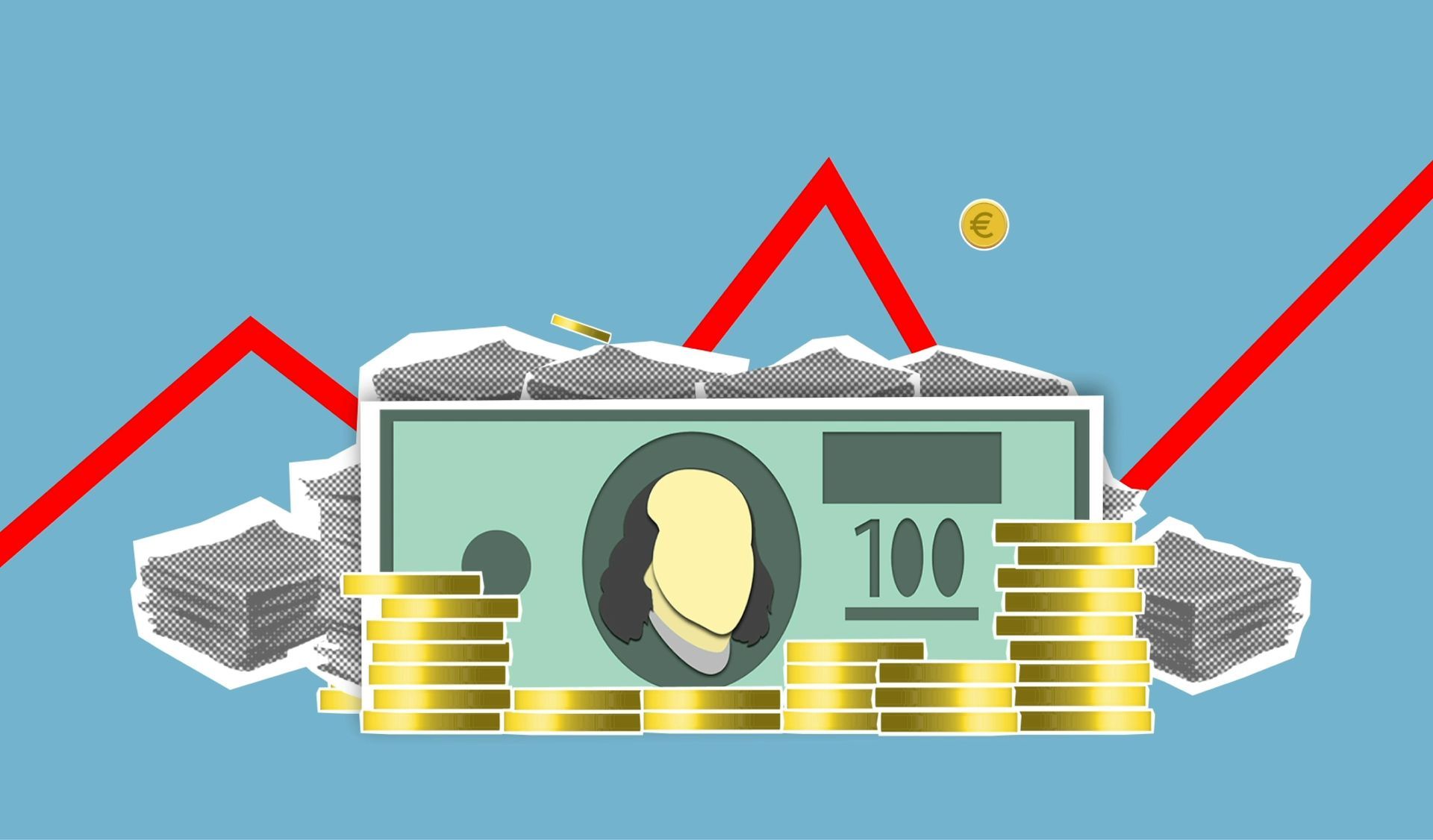Blog

American companies did well in the first quarter. During earnings season, publicly held companies tell investors how they performed during the previous quarter with a particular focus on earnings, which reflect company profits. Currently, we’re more than halfway through earnings season, and companies in the Standard & Poor’s (S&P) 500 Index have reported solid performance results overall. “Both the percentage of S&P 500 companies reporting positive earnings surprises and the magnitude of earnings surprises are above their 10-year averages,” reported John Butters of FactSet. As of last Friday, 72 percent of S&P 500 companies had reported earnings, and the blended earnings growth rate was 12.8 percent. If earnings stay at this level, we will see a second consecutive quarter of double-digit earnings growth for the S&P 500, reported Butters. While first quarter earnings were strong, it’s unclear whether future earnings growth will be as robust. “During the month of April, analysts lowered EPS [earnings-per-share] estimates for the second quarter by a larger margin than average…Analysts also continued to lower EPS estimates for [calendar year] 2025,” reported Butters. The reasons for changing expectations may be related to two words that have been popping up more than usual on earnings calls: “tariffs” and “uncertainty”. “Several companies noted that the uncertainty surrounding tariffs is making businesses hesitant about investment decisions. That means they are delaying stocking up on inventory (or in some cases, overstocking), hiring, and dealmaking,” reported Sabrina Escobar of Barron’s. “All the uncertainty has made it hard for companies to make accurate projections for the year ahead.” Last week, major U.S. stock indexes rose. “As of Friday, the S&P 500 index had risen nine days in a row, its longest streak since 2004. It jumped 10.2% in that span – 2.9% of that in the past week – a remarkable performance given the cloud of uncertainty hanging over American businesses,” reported Avi Salzman of Barron’s.

When investor preferences shift and money flows from one sector, industry, investment style or geographic region into another, it is called a market rotation. For years, stock markets in the United States have outperformed stock markets elsewhere. “The outperformance is attributed to U.S. exceptionalism fueled by a strong culture of innovation and entrepreneurship; more flexible labor markets; higher productivity; stronger consumer consumption driving demand for goods and services; a more favorable regulatory environment; lower corporate taxes; stronger intellectual property rights; and more open markets and trade policy,” reported Larry Swedroe of Morningstar. One consequence of U.S. outperformance is that investors outside of the United States own a lot of U.S. stocks, about $18.4 trillion, reported Tracy Alloway and Joe Weisenthal of Bloomberg. The percent of European investors’ total equity portfolios invested in U.S. stocks has more than tripled since 2011, in part due to strong performance. Now, Europe’s financial markets are outperforming those in the United States. “Across assets of all stripes, the Old Continent is collectively trouncing America in a way that’s rarely been seen before…German bonds last week beat Treasuries by the most ever. And while European shares have been knocked by the trade war, they’re turning out to be far more resilient than American ones,” reported Alice Gledhill, Abhinav Ramnarayan, and Julien Ponthus of Bloomberg last week. Over the last two months, global investors have backed away from United States markets. Bank of America’s monthly global fund manager survey found that asset managers have reduced U.S. allocations by more than half since February. “A majority think a trade war that triggers global recession is the biggest risk for markets,” reported Reuters. The recent geographic market rotation was a reminder of the importance of diversification. While diversification won’t prevent losses, it can help investors effectively manage risk. Investors who held a geographical diversified portfolio may have fared better this year than those who invested only in the United States.

All eyes on the bond market. The scale of the tariffs introduced by the administration shocked investors, sparking a roller coaster of a week for stock markets. Last week, U.S. stocks: · Rallied on a rumor. · Fell when the rumor was recognized as a rumor. · Rose when President Trump paused reciprocal tariffs on most countries for 90-days. · Fell as investors considered how the remaining baseline tariffs (10 percent on all countries, steel and aluminum tariffs, and 100%+ tariffs on China) might affect companies and economies. · Rallied after the Federal Reserve assured investors it was prepared to step in, if needed. “Economic angst enveloped every corner of Wall Street as U.S.-China trade tensions escalated, sparking a slide in stocks, the dollar and oil, with liquidations in U.S. assets pointing to disorder in the financial system,” reported Rita Nazareth, Isabelle Lee, Denitsa Tsekova, and Vildana Hajric of Bloomberg.” Disorder in the financial system Some of the disorder was found in the United States Treasury market where yields were moving higher when many expected them to move lower. Investors who are concerned about risk and sell stocks tend to seek financial shelter in investments that are perceived to be steady in a storm. For many years, United States Treasuries have been a “safe haven”. So, last week, there was an expectation that, as investors sought shelter from the tariff storm, rising demand would push Treasury yields lower. That wasn’t the case. Investors sold U.S. Treasuries, pushing yields higher, reported Sydney Maki and Carter Johnson of Bloomberg. “Billed as so rock-solid safe they’re risk-free, US Treasury bonds have long been the first port of call for investors during times of panic. They rallied during the global financial crisis, on 9/11 and even when America’s own credit rating was cut…But this time may be different. As President Donald Trump unleashes an all-out assault on global trade, their status as the world’s safe haven is increasingly coming into question…Yields, especially on longer-term debt, have surged in recent days while the dollar has plunged,” reported David Rovella of Bloomberg. The Federal Reserve (Fed) soothed the market On Friday, Minneapolis Fed President Neel Kashkari and Boston Fed President Susan Collins both discussed ways the Fed can “manage a dislocation, or pricing disruption, in the Treasury market…[the moves] are instruments designed to keep markets running smoothly by making sure there is enough liquidity, meaning financial institutions have access to the short-term funding they need to operate,” reported Nicole Goodkind of Barron’s. Markets were soothed by the assurance that the Fed stands ready to “keep financial markets functioning should the need arise,” reported Stephen Culp of Reuters. By the end of trading on Friday, major U.S. stock indices were in positive territory. Yields on longer maturities of U.S. Treasuries also finished the week higher.

Risk-on. Risk-off. If you read the financial press, you may have seen the terms “risk-on” and “risk-off”. When investing, there is a risk-return spectrum. Stocks typically have higher risk and higher return potential than high-quality bonds. High-quality bonds have lower risk and lower return potential than stocks, although they typically have higher risk and higher return potential than cash. In financial speak, investors are: · Risk-on when they are excited about investing in stocks (and other types of assets that have higher risk profiles). “Risk-on environments can be carried by expanding corporate earnings, optimistic economic outlook, accommodative central bank policies, and speculation. As the market displays strong influential fundamentals, investors perceive less risk about the market and its outlook,” reported Adam Hayes for Investopedia. A risk-on environment may lead to rising stock prices. · Risk-off when they become cautious and concerned about losses. Risk averse investors may sell some types of stocks (and other types of assets that have higher risk profiles) in favor of dividend-paying stocks and more stable types of investments that can help preserve principal. Risk-off environments may arise when economic growth slows, economic uncertainty rises, company earnings slide lower, consumer confidence wavers, or financial markets experience other kinds of disruptions. A risk-off environment may lead to falling stock prices. Last week, investors moved from a risk-on to a risk-off outlook. The change in attitude resulted from concerns about: · Tariffs . Concerns about tariffs intensified last week when “An unexpected move against car imports this week renewed warnings from economists that tariffs will almost surely raise consumer prices and harm economic growth,” reported Jeran Wittenstein and Ryan Vlastelica of Bloomberg. · Sticky inflation . Last week, the personal consumption expenditures (PCE) index, which is one of the Federal Reserve’s preferred inflation gauges, showed that headline inflation remained steady month to month and year to year. However, core inflation, which excludes food and energy prices, rose month to month and year to year. · Consumer sentiment . The final reading for consumer sentiment in March did not improve. “This month’s decline reflects a clear consensus across all demographic and political affiliations; Republicans joined independents and Democrats in expressing worsening expectations since February for their personal finances, business conditions, unemployment, and inflation,” wrote University of Michigan Surveys of Consumers Director Joanne Hsu. During periods of market volatility, it’s important to keep a long-term perspective. Having an asset allocation strategy that reflects your risk tolerance and financial goals helps insulate your assets from market turbulence. Asset allocation helps manage risk, but it does not prevent losses.

Almost one hundred years ago, Benjamin Graham and David L. Dodd wrote, “the market is a voting machine, whereon countless individuals register choices which are the product partly of reason and partly of emotion.” Today, the same holds true. Stock prices are influenced by many factors. Here are three examples: 1. Market trends . Last year, companies with strong momentum characteristics—meaning their prices were trending higher—generally did well. “The main rationale behind momentum investing is that once a trend is well-established, it is likely to continue,” reported the Corporate Finance Institute. The idea may seem contrary to the primary rule of investing, sell high and buy low, but the approach is backed by academic research. It “captures the tendency for market trends to persist for a while, whether it’s because more investors are jumping in or are late to absorb new information,” reported Justina Lee of Bloomberg. As one researcher told Lee, “Momentum investing is great until it’s not.” 2. Investor sentiment. Emotion plays a significant role in stock market volatility. For example, last week, we saw a relief rally. Asian stocks rose and the Standard & Poor’s (S&P) 500 Index hit a new high because the news was less bad than investors had expected. Isabelle Lee, Lu Wang, and Phil Serafino of Bloomberg explained: “Despite the protectionist threats of the campaign trail, Trump held off on imposing levies on key trading partners this week, and just last night delivered his most mollifying message yet to China by saying that he would rather not have to use tariffs against the world’s second-biggest economy. Cue a relief rally across markets.” 3. Company fundamentals . Graham and Dodd recommended fundamental analysis to identify stocks with good value. Investors who rely on fundamental analysis study companies’ financial statements, and consider assets and liabilities, revenue and expenses, earnings and cash flow, and other factors. Then they do some math to evaluate the company’s value using various measures like the price-to-earnings ratio. In theory, a company with a low share price relative to its earnings is a good value. No one knows how markets will perform over the short term. That’s one reason it’s important to hold a diversified portfolio. Owning investments that perform differently in various market conditions helps manage investment risk and may smooth returns over time. Last week, major U.S. stock indices rose. The S&P 500 moved higher over the week, the Dow Jones Industrial Average gained 2.2 percent, and the Nasdaq Composite rose 1.7 percent, reported Paul R. LaMonica of Barron’s. Yields on U.S. Treasuries were relatively steady.

Last week, investors breathed a sigh of relief when the latest price data showed core inflation, which excludes volatile food and energy prices, moved lower in December. Investors has been worried because economists forecasted inflation would be stickier in December, reported Frank Lee of Morningstar. If that proved out, the Fed might have stopped lowering the federal funds rate, which would have had adverse implications for company performance and stock prices. So when core inflation dropped to 3.2 percent year over year, investors celebrated. Some think the celebration might be premature. Jacob Sonenshine of Barron’s reported, “Stocks jumped after this week’s inflation data. The problem is that there’s not a lot to love in the numbers. The reality is that inflation remains well above the Federal Reserve’s 2 [percent] goal. The average headline [Consumer Price Index] has been 2.7 [percent] in the past three months, above the 2.6 [percent] average for the three months that ended in September. So the trend of inflation, when considering a larger sample size of results, is inching higher, not lower…The result is that the Fed is unlikely to reduce interest rates aggressively. The federal-funds futures market now expects just one interest-rate cut this year…” Inflation wasn’t the only reason investor optimism surged last week, though. Fourth quarter earnings season—the time when management lets investors know how the companies performed in the prior quarter—got off to a strong start. “Big Banks set a positive note earlier this week, while [a large semiconductor company] sparked further enthusiasm among chip stocks. Things will only heat up in the weeks ahead, as Wall Street sizes up results from the market's heaviest hitters,” reported Connor Smith of Barron’s. We should all be prepared for markets to be volatile this year. While last week delivered attractive gains overall, the week before stock and bond markets moved in the opposite direction. Jurrien Timmer of Fidelity explained why we may see significant volatility this year: “While I continue to believe we are in a bull market—with rising earnings poised to pull the weight of the market still higher—this recent volatility could be a sign of things to come. Later stages of a bull market tend to be more volatile. And it doesn’t take as much to disrupt the market’s mojo when valuations like price-earnings (PE) ratios are high, as they have been. But moreover, I believe the interest-rate angst that’s been weighing on the market isn’t likely to go away anytime soon, and could be a recurring feature of the year ahead.” Last week, major U.S. stock indices rose sharply, and yields on longer maturities of U.S. Treasuries fell.

Not one, but two! United States stock markets are serving another cup of cheer this year. The Standard & Poor’s (S&P) 500 Index returned more than more than 24 percent in 2023. This year, it was up 26.5 percent through the end of November. It’s possible 2024 will end up in Wall Street’s bull market hall of fame, wrote Jan-Patrick Barnert of Bloomberg, because the year-to-date return of the S&P 500 ranks among its best performances of this century. “Not many expected another blistering rally fueled by a handful of tech titans and market sentiment so bullish that one risk event after another got cleared without a scratch… Market swings were benign, with only one big valley of tears: a summer pullback that culminated in a small selloff around early August. The drop lasted for just less than a month and failed to cross the threshold of 10 [percent], typically seen as a correction.” On a relative basis, U.S. stock markets have significantly outperformed stock markets elsewhere. Consider the performance of a few non-U.S. indexes through Thanksgiving. Index name Year-to-date return (thru Nov. 28, 2024) MSCI Europe 0.98 percent MSCI Europe, Australia and the Far East (EAFE) 2.95 percent MSCI Emerging Markets (EM) 5.46 percent MSCI Japan 6.14 percent MSCI China 12.91 percent MSCI India 13.54 percent Over the year, the number of U.S. stocks participating in the rally rose. “The rally is broadening out…more stocks are advancing than declining. Typically, that phenomenon bodes well for the entire stock market. It’s a sign of better market breadth, meaning that the major indexes aren’t being led by just a small handful of stocks,” reported Paul R. La Monica of Barron’s. However, La Monica also cautioned against becoming complacent, “…given how long it has been since Wall Street has faced any significant obstacle, it isn’t entirely clear what might happen if market or economic conditions suddenly head south.” Last week, stocks jolted up and down as investors responded to data about political appointments, tariffs, and inflation data. By the end of the week, major U.S. indices were higher. Treasury bonds gained, too, as yields moved lower after president-elect Donald Trump nominated hedge-fund billionaire Scott Bessent to be U.S. Treasury Secretary. Many believe Bessent could be a moderating influence when it comes to taxes, tariffs, and the deficit, reported Mitchell Hartman of Marketplace.

The United States stock market changed course. Last week, the strength of the United States economy slowed investors’ roll. Federal Reserve (Fed) Chair Jerome Powell told business leaders in Dallas, Texas, that the performance of the United States economy has been “remarkably good,” better than any major economy in the world, which gives the Fed “the ability to approach our decisions carefully.” Powell’s comments caused investors to reassess the likely pace of rate cuts. As they did, the probability of a December rate cut fell sharply, according to the CME FedWatch Tool. The likelihood that the Fed may lower rates more slowly than expected roiled markets. Lu Wang, Isabelle Lee, and Emily Graffeo of Bloomberg reported, “With the world’s most important central banker in no hurry to ease monetary policy thanks to a still-robust labor market and strong economic data, bond yields once again rose and dragged stocks lower in their wake. Down 2 [percent] over five sessions, the S&P 500 erased half of its trough-to-peak gains since the election. Combined with losses in corporate credit and commodities, the week rounded out a pan-asset retreat that by one measure was the worst in 13 months.” Investors’ changing outlook was shaped by other factors, too. These included: · Elevated stock valuations . Bella Albrecht of Morningstar reported, “The U.S. stock market is trading at an 11 [percent] premium to its fair value estimate.” The data reflected share prices on November 13, which was midway through last week. · The risk of inflation rising again . Many economists believe the incoming administration’s spending and tax policies have the potential to reignite inflation, which could lead the Fed to reassess monetary policy. · A disrupting cabinet nomination . Robert F. Kennedy Jr. to lead the Department of Health and Human Services rattled healthcare and consumer staples sectors of the market. “Shares of biotechnology and pharmaceutical companies fell, with the S&P 500 Pharmaceuticals index down about 2 [percent]. Shares of packaged food and beverage giants…also declined,” reported Samuel Indyk and Ludwig Burger of Reuters. By the end of the week, major U.S. stock indices were down. U.S. bond markets continued to be wary of tariffs and inflation, lifting the yield on the benchmark 10-year U.S. Treasury to 4.5 percent. By week’s end, though, the 10-year Treasury yield had settled at 4.3 percent, reported Liz Capo McCormick of Bloomberg.

Financial markets appear to have pre-election jitters. The United States election is less than two weeks away. The candidates are neck and neck. The outcome remains uncertain. And expectations for volatility have been rising, with the CBOE Volatility Index (VIX) finishing last week at 20.33. “When the VIX goes north of 20, Wall Street pays attention because that level signals heightened volatility,” reported Connor Smith of Barron’s. One reason for heightened volatility may be concerns about the election. Ian Salisbury of Barron’s explained, “There are plenty of theories about how particular stocks will fare, depending on next month’s outcome. It isn’t hard to see why. The candidates have tried to curry favor with voters by championing or attacking favored industries, and sometimes individual companies. Vice President Harris has promised to raise the corporate tax rate, a move that could cut into corporate earnings, and Democrats are widely seen as tougher on antitrust issues, a potential hurdle for Wall Street banks looking to capitalize on pent-up [merger and acquisition] activity. Trump, meanwhile, has threatened hefty new tariffs, which could help U.S. manufacturers but hurt multinationals. He’s even threatened individual companies like John Deere over plans to move manufacturing facilities abroad. The good news? Investors can mostly shrug the campaign rhetoric off and focus on stocks’ fundamentals.” So far, third-quarter earnings reports have been strong. Regardless, stock market investors became significantly less bullish last week, according to the AAII Investor Sentiment Survey. The survey asked investors whether they think the stock market will move higher (bullish) or lower (bearish) over the next six months. · Bullish sentiment declined from 45.5 percent the week of October 16 to 37.7 percent last week. (The historic average for bullishness is 37.5 percent.) · Bearish sentiment increased from 25.4 percent to 29.9 percent. (The historic average for bearishness is 31 percent). · Neutral sentiment also increased from 29.2 percent to 32.4 percent. (The historic average is 31.5 percent.) Bond investors also have been adjusting their expectations. Since mid-October, the yield on the benchmark 10-year U.S. Treasury note has trended higher. At the start of the month, the 10-year note yielded 3.74 percent. Last week, its yield rose from 4.07 percent to 4.23 percent. “The rise is likely a reflection of the fact the Federal Reserve will cut interest rates fewer times than investors had thought after September’s Federal Open Market Committee meeting, a result of inflation being above its target and a job market that has grown faster than expected. Also, Donald Trump’s chances of winning the presidential election have risen in the past few months, according to RealClearPolitics. His policies include fiscal spending and tariffs, both of which create inflation and throw cold water on the idea that the Fed will cut rates many times. While the economy could continue to grow, tariffs, for their part, not only lift prices, they destroy demand,” reported Jacob Sonenshine of Barron’s. Ben Levisohn of Barron’s offered some advice to anyone getting swept up in pre-election jitters. “The truth of the matter is that reading the financial market tea leaves is far from straightforward…In fact, investing with your politics is one of the worst ways to lose money—or miss out on gains.” If you have concerns about market volatility or the possible effect of the election on your portfolio, get in touch. We’re happy to talk with you about your concerns and your portfolio.

The Standard & Poor’s 500 Index closed above 5,800 for the first time—and that’s not all. The Dow Jones Industrial Average also notched a record high last week—and all three major U.S. stock indices ended the first full week of October with gains of more than one percent. There was good economic news, too. Inflation continued to slow in September. The Consumer Price Index showed headline inflation was 2.4 percent annualized—the smallest annual increase since February 2021. Consumers are feeling better than they did a year ago. “[Consumer sentiment] is currently 8 [percent] stronger than a year ago and almost 40 [percent] above the trough reached in June 2022,” reported University of Michigan Surveys of Consumers Director Joanne Hsu. The economy continues to grow. After inflation, the U.S. economy grew by 3 percent in the second quarter of 2024. Forecasts project that economic growth in the third quarter will be 3.2 percent. Wages have grown faster than inflation. In September 2024, average hourly earnings were up 4 percent. After inflation, they were up 1.5 percent. Of course, that’s a broad reading for the entire country and may not reflect individual experience. “By just about every measure, the U.S. economy is in good shape. Growth is strong. Unemployment is low. Inflation is back down. More important, many Americans are getting sizable pay raises, and middle-class wealth has surged to record levels. We are living through one of the best economic years of many people’s lifetimes…The United States has nearly 7 million more jobs than it did before the pandemic, and the largest share of 25- to 54-year-olds working since 2001,” reported Heather Long of The Washington Post. It's remarkable that many Americans still don’t recognize the strength of the economy. Last week, a Harvard Caps/Harris Poll found that, “63 [percent] of voters believe the U.S. economy is on the wrong track and 62 [percent] characterize it as weak, consistent with perceptions over the past year.”
